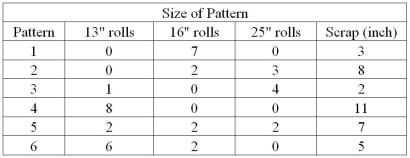Use the scenario below to answer the following question(s) .
A company makes standard 115-inch-wide rolls of thin sheet metal,and slits them into smaller rolls to meet customer orders for widths of 13,16,and 25 inches.The demands for these widths vary from week to week.From a 115-inch roll,there are many different ways to slit 13-,16-,and 25-inch pieces.
A cutting pattern is a configuration of the number of smaller rolls of each type that are cut from the raw stock.Of course,one would want to use as much of the roll as possible to avoid costly scrap.For example,one could cut seven 16-inch rolls,leaving a 3-inch piece of scrap.Finding good cutting patterns for a large set of end products is in itself a challenging problem.Suppose that the company has proposed the following cutting patterns:  Demands this week are 1,000 13-inch rolls,1,430 16-inch rolls,and 1,260 25-inch rolls.The problem is to develop a model that will determine how many 115-inch rolls to cut into each of the six patterns in order to meet demand and scrap.
Demands this week are 1,000 13-inch rolls,1,430 16-inch rolls,and 1,260 25-inch rolls.The problem is to develop a model that will determine how many 115-inch rolls to cut into each of the six patterns in order to meet demand and scrap.
Define Xi to be the number of 115-inch rolls to cut using cutting pattern i,for i = 1,…,6.
Note that Xi needs to be a whole number because each roll that is cut generates a different number of end items.
-Determine the objective function.
Definitions:
Informative Power
The capability of a message or source to significantly increase a recipient's understanding of a topic or issue.
Parallelism
The use of similar structures in writing or speech to create a balance and enhance readability or impact.
Lists
Ordered collections of items, information, or tasks, often used for organization, referencing, or planning purposes.
Simplify
To make something easier to understand or do by reducing its complexity or breaking it down into more manageable parts.
Q1: Identify the average number of customers in
Q12: How does Wallerstein (world systems theory)refer to
Q29: From the forecast charts for accepting 210
Q35: Where does Canada rank on the 2014
Q38: A rate of return required by management
Q45: Commodity chains are less common in labour-intensive
Q78: Which term refers to all of the
Q83: What is the probability that the system
Q148: Alex respects all of his university classmates.He
Q163: Carol,Bill,and their daughter live paycheque to paycheque,having